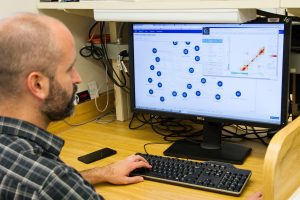NHS Digital has just published the latest figures on cancer survival in England. This data includes all adults and children diagnosed with cancer and gender, geography and deprivation from 2015 – 2019. Not all the data references brain cancer.
Just a word about where this data has come from: in October 2021, responsibility for the National Disease Registration Service (NDRS) transferred from Public Health England (PHE) to NHS Digital. NHS Digital is the data controller for this data. The National Cancer Registration and Analysis Service (NCRAS) as part of the NDRS is still responsible for collecting data on patients with cancer in England and continues to produce the cancer statistics publications.
What are the key messages for brain cancer?
Bottom line is that, as we’d expect, there is very little difference for adults diagnosed with a glioblastoma, the most aggressive of brain tumours. One year survival hovers around 41% (which is an improvement) whilst 5 year survival is low at 12.5%. The one year survival may be down to better neurosurgical techniques such as 5ALA and neurosurgical imaging techniques, but we don’t have the evidence at the moment. Women tend to do better than men (14% v 11% at five years) – but we don’t know why.
The data for children tells a different story. Childhood cancers accounted for 0.3% of all new cancer diagnoses registered in 2019 with the majority of cases being either leukaemia, malignant brain tumours or non-Hodgkin lymphoma. Whilst we don’t have the breakdown to show what percentage of children have a ten year survival after diagnosis, 81.7% do – this is the highest percentage since data has been collected (2002).
Why is a glioblastoma (GBM) so difficult to treat?
This is such a simple question to ask but it is very complex to answer. And that is because there are many reasons, some of which are outlined here. As ever, these are generalisations and not all of these points apply to all GBMs. So please remember that the more we know about these tumours, the more personal and targeted the treatments can be – that is why we need the research to optimise the treatments. And we need to explore the barriers so that we can remove them. It may be that we never find a cure, but I think most of us would accept living a long life with a GBM and a good quality of life for many years.
Surgery
GBMs are especially hard to treat because they aren’t contained in a defined mass with clear borders. Instead, the tumour includes thread-like tendrils that extend into nearby areas of the brain. This means it is impossible to remove all of the cancer cells and so the tumour will recur. And of course – the brain is a delicate and privileged site. It controls our very being so you can’t take a margin of tissue in the hope that you have all of the cancer cells. The damage would be too great.
Chemotherapy
There is a unique barrier around the brain (the blood brain barrier). This is there to protect the brain. So trying to get drugs through this barrier is hard. It limits the passage of molecules from the bloodstream to the brain. In addition, we know that some cancer cells are resistant to chemotherapy, or the cancer cells change over time and become more resistant. This is why when a GBM recurs it doesn’t have the same make up as when it first appeared. The tumour evolves and then has an advantage, as we don’t have drugs further down the line to use when it comes back.
Other drug therapies
It is thought that individual treatment agents are going to fail because the tumour develops multiple pathways that need to be stopped at the same time. So working out which combinations of drugs, when to deliver, how to deliver and to whom adds considerable complexity.
Data
On the one hand we need data to be able to do the research, but data can also confound research. The data sets we have (which are managed by the NDRS) are amongst the best in the world – but this too can bring challenges. We are data rich but information poor; it’s how we use it so that it is meaningful and changes practice for the better that is key. Data can change things – if we ask the right questions.
To really make data work so that it is transformative for research into GBM we need to:
- Understand the range and scope of data that exists
- Break down the silos that bind data
- Understand better data security and the risks that surround this. Sometimes the discussion will be around risk v benefit
- Develop the technological infrastructure so that it works seamlessly for us
- Stop regarding data as a propriety asset.
What else makes it hard to treat a GBM?
Well, small cohorts of people. Brain cancer is a less common cancer (rather than a rare cancer). But this means that we don’t have large numbers of patients to support a trial and so accrual to trials is a challenge. The recent World Health Organisation re-categorisation of brain tumours is a step in the right direction in that we know that there are subsets of tumours types, but this too makes it hard to have larger cohorts of patients involved in trials.
And then there are the trials themselves. Sometimes they aren’t rigorous enough, they lack public and patient involvement, they take too long to set up, they aren’t relevant for the community, they don’t reflect value for money. There are many reasons why trials don’t get funded. At the moment COVID 19 has caused a hiatus – clinicians have been hard pushed to manage current patient load without thinking about research and any research bids have been COVID 19 focused.
A good research question has to:
- Be important to the NHS and its patients
- Be supported by current evidence
- Have no overlapping studies in progress
- Be of high scientific quality
- Be feasible – it has to work
- Be timely – it will be relevant when the study is finished
- Be clear and well defined. It has to ask what is the population, what is the intervention, what is the comparator and finally the outcome
- Represent value for money.
That’s a lot of boxes to tick.
If you would like to use your experience and insight to support clinical research, consider signing up to be a PRIME advocate for brainstrust.
If you or someone you love is living with a brain tumour and have any questions around this latest news, or want to access support, give us a call on 01983 292 405 or email hello@brainstrust.org.uk. You can also visit our little brainstrust website which features support for children affected by brain tumour.






